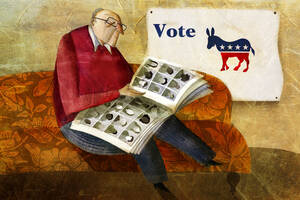Policy Politics & Elections Jun 3, 2024
Why Did Early Governments Emerge?
Was it about cooperation—or exploitation? A new study turns to archeology for answers.

Jesús Escudero
History tells us quite a bit about when and where the first governments formed: roughly 5,000 years ago, in the pockets of civilization that coalesced around large rivers in ancient India, China, and the Middle East. But much less is known about why these state-like institutions—where ordinary people gathered in special buildings to collect taxes, manage public services, and mediate disputes outside their own kin—formed in the first place.
“These days, we’re used to having government in our lives—but historically speaking, government is rare,” says Leander Heldring, an assistant professor of managerial economics and decision sciences at Kellogg. “Most of the time, the hassle of dealing with all these people [outside of your own tribe] was just not worth it. So to me, it’s always been a completely remarkable fact that we humans managed to innovate these institutions.”
Social science currently offers two broad explanations for the origin of government—neither of which is conclusive. The “extractive” theory assumes that might makes right: powerful groups took resources from weaker ones and installed themselves as elites to perpetuate the cycle, in a kind of “institutionalized bullying,” says Heldring. Meanwhile, the “cooperative” theory posits that government was invented to coordinate certain tasks between groups, where the net benefit of collaboration outweighed the relative simplicity of avoiding or conquering each other.
“People have been thinking about this since the time of the ancient Greeks,” Heldring says. “What we set out to do is see if we could bring some empirical evidence to the question.”
To do so, Heldring and his collaborators (Mattia C. Bertazzini of Oxford University and Robert C. Allen of New York University Abu Dhabi) analyzed centuries worth of archaeological data from the ancient Sumerian civilization, which occupied the famous “fertile crescent” in what is now modern-day Iraq. By analyzing how local communities responded to changing river flows in the region, the researchers found multiple lines of evidence supporting the cooperative theory of government.
“What we see emerge is something like a social contract: people giving up some of their own resources and authority in exchange for ‘public benefits,’” Heldring says. “Human societies are incredibly diverse, so it’s not the case that this settles things once and for all. But if we’re asking whether the origins of government, by and large, are about cooperation or stealing, this is a piece of evidence [for the former] in one of the first governments in history.”
Shifting rivers, shifting fortunes
Ancient Mesopotamia was not the only place where government first emerged, but it is one of the most exhaustively studied places on Earth by archaeologists. For Heldring and his coauthors, this made it an ideal region to search for evidence of cooperation or extraction in early states. “The Middle East was researched in an extremely comprehensive, systematic manner between 1930 and 1990,” Heldring says. “Imagine people holding hands across the desert and walking from Baghdad to the sea, picking up everything they could find.”
The researchers used these historical “sweep surveys” to assemble an archaeological map of the region divided into five-kilometer squares. Any evidence of early state formation between 3900 BCE and 2700 BCE would be contained within these squares. “We could be confident that if nothing showed up [in a particular square], it was really because nothing happened there—not because no one thought to look,” Heldring explains. He and his collaborators used these grid squares to “time travel” within every patch of desert in the region: seeing where groups of people settled down in farms, villages, and cities, how long they stayed, and what they built.
“What we see emerge is something like a social contract: people giving up some of their own resources and authority in exchange for ‘public benefits.’”
—
Leander Heldring
Special buildings within cities, called ziggurats, have long been known to archaeologists as centers of government business. Heldring and his coauthors used these ziggurats as clues to determine where, and when, local governments appeared in the region. But to shed light on why, they needed more information. Five thousand years ago, the region had only one river, called the Ur (which would later split into the Euphrates and Tigris). Periodic surges in the Ur’s flow, combined with the relative flatness of the land, would cause the river’s path to suddenly change. In response, local settlements either moved to follow it, or stayed put while building canals to bring the river’s water back to them. This canal construction would have required social coordination between groups, rather than just within them—making it another clue not just to the presence of local government, but to its purpose as well.
“If the river moved and you try to dig a canal, it’s quite likely that there are other communities sitting between you and where the river is now,” Heldring explains. “So if you want to get that done, you have to work together with those people.”
By comparing the timing and location of these “river shifts” to the construction of ziggurats and canals, the researchers were able to build what Heldring calls “a perfect natural experiment” for observing the origins of government. If the river shifted away from a settlement, and this was followed by the construction of both canals leading back to the settlement and ziggurats in a nearby city, it would suggest that local government had formed in order to facilitate the necessary cooperation. By contrast, if the river shifted toward a settlement, and ziggurat construction soon followed, it would indicate that an extractive government had appeared in order take advantage of the new resources. (Canals, meanwhile, wouldn’t even be necessary.)
“If government is really all about taking stuff away from people, you’d expect to see states form where there’s stuff to take away,” Heldring explains. “But if it’s actually about trying to cooperate with one another, and building organizations to facilitate that, then you’d expect to see states form in the resource-poorer places where people have to get along in order to stay put.”
Words and deeds
Heldring and his collaborators found three lines of evidence supporting the theory that early governments were formed to facilitate cooperation.
The first was that local communities did tend to form states after rivers shifted away, rather than toward them. According to the archaeological record, any given grid square in the region was about twice as likely to become part of a state after one of these shifting-away events (as evidenced by the appearance of ziggurats in a nearby city). The timing of the events also showed that these new states formed in response to river shifts, not because a previously existing government just happened to expand into new territory.
Second, the formation of new states was quickly followed by the appearance of “public works”—in this case, canals—designed to benefit local communities, not steal their resources. The researchers found that after a river had shifted away from a grid square, the probability that it would soon be irrigated by a canal increased by 40 percent.
“You can reconstruct the borders of a state and observe some new ziggurats, but it doesn’t tell you much [about the purpose of government] if nothing else gets done,” says Heldring. “That’s why this second finding is important: we see that something actually gets done to solve a problem. And, in fact, it’s the very problem that we think started this whole need for cooperation in the first place”— that is, keeping settlements irrigated after the river shifted away from them.
The researchers’ third line of evidence came from a different archaeological source: written records. The ancient Sumerians left behind thousands of clay tablets containing wedge-shaped symbols, called cuneiform, that comprised the world’s earliest-known writing system. By analyzing existing translations of nearly 6,000 such tablets, Heldring and his coauthors often found “receipts” for tributes paid by communities to the state. In grid squares where a river shifted away, the likelihood of finding these receipts in the nearest city doubled—further indicating the presence of a fundamentally cooperative social contract, in which settlements traded goods and autonomy to the local government in exchange for beneficial services (like canals). The researchers even found a new word appearing in the tablets following the formation of states: lugal, a kind of bureaucratic title meaning “chairperson” rather than “chief.”
“There are basically zero mentions [of lugal] anywhere before a state forms, but in places where states do form, then people start mentioning it,” Heldring says. “So there’s evidence coming from two sides. Not only do we see people building things, which leaves an archaeological record in the ground, we also see people writing about exactly what they should be writing about if they were ‘scaling up’ their preexisting social institutions into this new way of working together.”
Beyond history
There is academic value in shedding light on why the first governments may have formed. But Heldring’s findings also cast light on longstanding concerns about the purpose of government—concerns that are very much alive today.
“It’s a contribution to this fundamental debate that’s been running for hundreds and hundreds of years: How do we, as citizens, relate to the government?” he says. “If you view the government as an enemy in principle, just trying to take stuff for itself, then you’ll see your duty as a citizen as keeping the government at arm’s length, because who knows what it might do. That attitude is prevalent in parts of the United States and Europe, and it can lead to less-cooperative relationships between the state and society.
“Another attitude is that ‘we’re in this together,’” he continues. “Every government in every country overreaches at times—sometimes egregiously so. But if you view government’s basic ‘job’ as trying to do the right thing for its society, it becomes self-reinforcing: it helps structure everybody’s attitude towards cooperation in society.”
Of course, no government is fully cooperative or wholly extractive. And while his findings lend credence to the idea that the first states formed in order to enable cooperation, Heldring believes that over time, governments do tend to bend toward coercion.
“We see it clearly in the archaeological and historical record,” he says. “Initial assembly meetings become less important, and you see people becoming enforcers within bureaucracies. So even if the initial push for developing these institutions was coordination, afterwards you’d still have to protect them. And that tension is very much still with us.”
John Pavlus is a writer and filmmaker focusing on science, technology, and design topics. He lives in Portland, Oregon.
Allen, Robert C., Mattia C. Bertazzini, and Lender Heldring. 2023. “The Economic Origins of Government.” American Economic Review. (113 No. 10): 2507–45.



